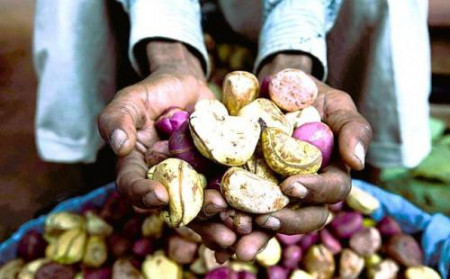(Business in Cameroon) – Cameroon’s kola nut production has hovered around 48,500 tons annually over the past five years, accounting for 15.4% of global output. This places the Central African Economic and Monetary Community (CEMAC) economic powerhouse as the world’s third-largest kola nut producer, according to Tridge, an agricultural market intelligence and food product trade platform.
Cameroon trails Nigeria and Côte d’Ivoire, the top two international suppliers of the product. Tridge data indicates that Nigeria, the West African giant, produced 174,100 tonnes in 2022, representing 55.2% of global production. Côte d’Ivoire’s output in 2022 reached 58,640 tonnes, or 18.6% of the world total.
The global top five kola nut producers are completed by two other African nations. Ghana ranks fourth, with a 7.8% market share and 24,643 tonnes produced in 2022. Sierra Leone follows, with 8,450 tonnes during the review period, accounting for 2.7% of the global kola nut market.
Analysts predict that these five market leaders will see increased returns from kola nut cultivation in the coming years due to rising demand. A study published in April 2025 by Cognitive Market Research, cited by Ecofin Agency, estimates the kola nut market to be worth $119 million (approximately 65 billion CFA francs) in 2025. The study projects the market to grow by an average of 3.3% annually through 2033.
This anticipated surge in the global kola nut market is fueled by the diversification of its uses. While traditionally consumed in its raw form across many African countries, market analysts note a growing demand for kola nut in the agri-food industry, cosmetics, and traditional medicine.
Kola nut exports are not explicitly listed in Cameroon’s 2022 and 2023 foreign trade reports, published by the National Institute of Statistics (INS). However, this does not necessarily mean the country has no exports of the product. It is plausible that, similar to other agricultural goods like cotton, cereals, and even cocoa, Cameroonian kola nuts are exported through informal channels to Nigeria, the world’s leading producer. Cameroon shares a long and porous border of approximately 1,500 km with Nigeria.
Despite probable informal exports, as well as local consumption and still-limited artisanal processing, which are the primary uses of kola nut in Cameroon, the forecasted growth in this product presents a significant opportunity for both industry stakeholders and public authorities to better position kola nut on the national and international economic stage.
Brice R. Mbodiam



































